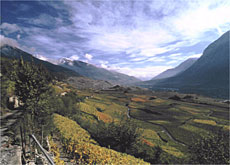
Reaching for the summits

Valais is famous for its mountains, but its wines are a well-kept secret.
Canton Valais not only has more 4,000 metre peaks than any other region of the Alps, it also boasts Switzerland’s largest winegrowing region, with 5,200 hectares of vineyards.
Two things catch the eye while travelling along the Rhône River that cuts through the heart of the canton: the terraced vineyards claiming the northern slopes and the majestic peaks high above them.
Despite being so adept at marketing its mountains, the Valais has failed to make its wines known abroad. One of France’s most celebrated food and wine critics, Gilles Pudlowski, says this is great pity.
“If Valais did a better job marketing its wines abroad, some of the world’s best vineyards would finally be discovered,” Pudlowski said in a recent interview.
One of the best places to taste some of the region’s 50 different varieties is the Château de Villa in the town of Sierre.
Rare varieties
More than 500 local wines are showcased inside the château’s rustic wine bar – including many rare varieties that are produced only in small quantities.
Diego Zenklusen of the wine producer Adrian Mathier, led swissinfo through a tasting of some of Valais’ best and least known wines.
“This ‘Dôle’ is a blend of mainly Pinot Noir and Gamay, with Pinot Noir making up at least 51 per cent of the wine,” Zenklusen says, holding up a glass of one of Switzerland’s best-known wines.
“It’s lighter than a pure Pinot Noir, and it’s more fruity because of the Gamay.”
Fresh and fruity
The Chasselas grape – known as “Fendant” in Valais – is the most widely cultivated white wine variety in Switzerland, and accounts for 30 per cent of all wine production in Valais.
The fresh and fruity wine goes down well as an aperitif or with traditional Valais cheese dishes like Raclette and Fondue.
But Zenklusen says Fendant’s reputation has suffered – undeservedly – in recent years.
“Demand has gone down because people are looking for different wines and if you suggest a Fendant, they often say ‘don’t you have anything else?'”
Old red wine
We then move on to a “Cornalin”, one of the oldest grape varieties, which is exclusive to the canton, with no close or even near relative.
“The name was created in the 1980s. Before that it was simply known in Valais as ‘old red wine’ and nothing else,” Zenklusen says.
A vine demanding slopes most exposed to the sun, Cornalin has won the praise of wine critics like Pudlowski, thanks to its complex bouquet and full body.
Humagne Rouge
Cornalin and Humagne Rouge are among the most sought after reds, while Humagne Blanche, Amigne and Petite Arvine count among the top whites.
However, quantities are so small that connoisseurs have to travel to Valais to taste them – which really is not such a bad thing at all.
Visitors can discover the wines and learn about Valais’ unique winemaking traditions while taking in the breathtaking scenery.
Curious customs
There are few better places to do so than around Sierre. A six-kilometre interpretive trail winds through the vineyards between Sierre and the neighbouring town of Salgesch.
The vines are often labelled, and information boards let walkers in on the secrets of winemaking and reveal curious Valais customs.
For centuries, people from the mountain villages in the high altitude side valleys would migrate down to the Rhône in spring just to prepare the vineyards, move back to their homes for the summer, and return in the autumn for the harvest, before, once again, packing up all their belongings and heading for the hills for the winter.
A guide at the wine museum in Salgesch, Heidi Kuonen-Goetz, explains that the villagers of the Val d’Hérens even went to the extreme of carrying the harvested grapes, uncrushed, back up to their homes in order to process them and make wine.
Kuonen-Goetz says of the 1,200 people in Salgesch, almost all are involved in one way or another in winemaking – a testimony of its cultural importance to this day.
“Either they have their own little plot or they’re helping out family members, or they are working for a company,” she says.
In fact, the Valais vineyards are divided up into an incredible 22,000 separate properties but most are less than two hectares in size.
“Bigger is not better,” says Zenklusen. “It’s important to produce good wines, no matter how small you are.”
swissinfo, Dale Bechtel in Sierre
Valais’ 5,200 hectares of vineyards are divided up into 22,000 separate properties.
More than 40 different grape varieties are grown in the region however Chasselas, Pinot Noir and Gamay account for 85 per cent of the total surface area of the vineyards.
The main wines produced are Fendant (white wine made from 100 per cent Chasselas) and Dôle (red made mainly from Pinot Noir and Gamay).
Old varieties unique to the Valais are making a comeback: Petite Arvine, Amigne, Humagne Rouge and Cornalin.
The Valais village of Vispertermin has Europe’s highest vineyards, stretching up to 1,100 metres above sea level.

In compliance with the JTI standards
More: SWI swissinfo.ch certified by the Journalism Trust Initiative
































You can find an overview of ongoing debates with our journalists here . Please join us!
If you want to start a conversation about a topic raised in this article or want to report factual errors, email us at english@swissinfo.ch.